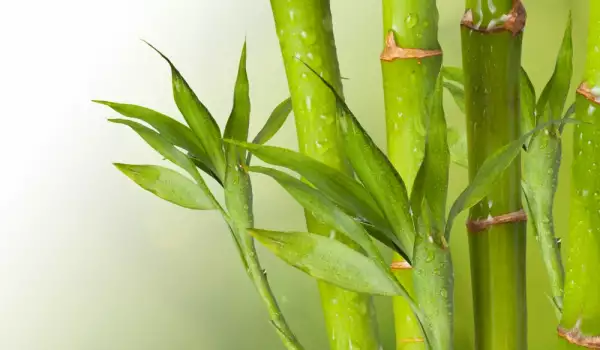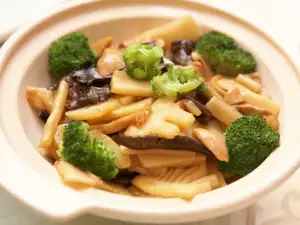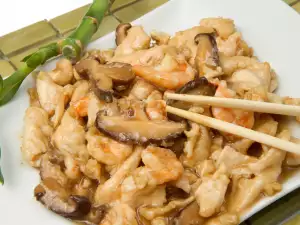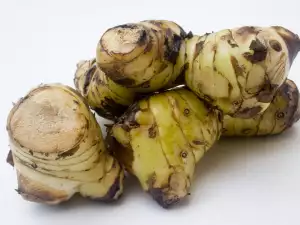Bamboo is a group of evergreens. It has powerful smooth stems, but does not fall into the category trees, and is part of the kingdom of the grass plants. Usually there are huge amounts of them, but it belongs to the family Poaceae (Poaceae), forming a separate subfamily (Bambusoideae). To this genus belong about 50 generaeswith over 700 species of grass. The eternal home of bamboo is the region of the tropics and subtropics in Asia, Africa and America. Bamboo grows in dense large communities, often forming forests. Bamboos can grow even in the Himalayas, at very high altitudes - up to 4500 meters.
In China and the Far East, bamboo is embedded in traditions and all walks of life since millennia. Bamboo had (and has to this day) multifunctional application - has accompanied the people throughout their life cycle, served food, weapons, medicine, writing on bamboo scrolls happened in early written records, producing paper, musical instruments, toys, gazebos, bridges, irrigation canals, fences, furniture, flooring, lights, craft food, hats, shoes, boats and more. From bamboo to this day are made household items and crafts such as furniture and flooring. Historically craftsmen drew on the bamboo works of art - classical paintings, calligraphy and poetry.
Along with the chrysanthemum, plum and orchid, bamboo is determined by ancient Chinese sages as one of the four noble plants. Pine, bamboo and plum are called "three friends of winter" because only they best withstood the cold gusts of a winter wind. Bamboo was valued mostly for its qualities related to health, longevity, durability, flexibility, growth out and up, simplicity, honesty and spiritual exaltation.
Bamboo is monocarp plant, ie. Unpredictable. It blooms only once in its life and dies after. Blossoms rarely - some species bloom once in 30 to 32 years, others - 60, even 100 years old. The flowers are small, hidden in the folds of the leaves and are inconspicuous or collected in large clusters. A sudden blossom of a bamboo forest is considered an exceptional event, and promises deliverance from hunger, as the seeds do not yield to bamboo rice in their taste and quality.
Species of Bamboo
Among the major types of bamboo are included those from the Dendrocalamus, Phyllostachys, Shibataea, Pseudosasa, Sinarundinaria, Pleioblastus, Bambusa and Arundinaria types. The types of bamboo are over 1000, but China alone has more than 400 species. The bamboo, which pandas eat is from the Fargesia species. It is very hard and small in diameter and used for other productive purposes.

Application of Bamboo
Bamboo is widely used in cooking. It is given as an ingredient in the preparation of dishes with fish, meat and vegetables. Bamboo seeds resemble rice in their taste and nutritional properties.
Tissues from bamboo are very popular mainly because of the antibacterial properties that they own. While growing bamboo, you need little or no pesticides. Scientists have discovered that this valuable quality is the result of the presence of anti-bacterial bio-agent named "bamboo Kuhn". Kuhn is deeply embedded in bamboo cages, and the durable bamboo fabric.
Growing Bamboo
The majority of the species are propagated by dividing the rhizome, but there are those that bloom grow fruit. Bamboo can withstand freezing temperatures and loves moisture. Bamboo is known for being one of the fastest growing plants on earth. Some species grow over 100 cm per day and go up to 40 meters in height. In Japan, bamboo, called "madake" (Phyllostachys bambusoides) grows. Its stems grow 24 hours a day with almost 120 cm being the greatest height reached by Burmese bamboo (Dendrocalamus giganteus), which is widespread in India and Burma. Tree trunks extend it to the grand height of 40 meters with a diameter of only 20-30 cm, reaching a significant size.
The root system of bamboo allows the plant to recover by itself after cutting, which makes it indispensable as a fast renewable resource. Bamboo forests emit up to 35% more oxygen than an identical array of other trees. Sowing in deserted areas with bamboo can be a powerful weapon in the fight against global warming.
A simple bamboo in a natural habitat grows to 25 meters, but grown in indoor conditions, after reaching a height of about 30-45 cm, the young shoots and seeds are used in modern cuisine, while the core contains sweet juice - known as bamboo sugar.
Bamboo grows on moist soils, in the bright sun in summer and in a wintery and dry habitat, protected from the wind. Bamboo is a winter- resistant plant resistant to minus 12 to 14 degrees, and for non-continuous terms, even cold as low as minus 25 degrees. All bamboo plants enjoy plenty of moisture and sunlight. The stems are hollow, gnarled and their narrow linear leaves have a length of about 10 cm

Growing bamboo in your home
Some types of bamboo are beautiful ornamental plants. Appreciate for terrestrial vegetation, thanks to which bamboo blends well with large-leaf plants. Cultivation of bamboo at home is not difficult, but there are some rules. All kinds of bamboo need a light, airy and well-lit rooms. The plant is placed in bright sunlight scattered at 12 to 16 degrees in winter.
Watered thoroughly during the summer, during the growing season soil should not dry. High species require regular watering and feeding during growth. Replanting seedlings each year, but in 2-3 years old.
In flower shops can often see strange spiral wrapped plants with bare stems and rosette of leaves at the top. Sometimes the stems look like tubes made and sold knotted bundles. In both cases, the plants are named Bamboo happiness (Lucky Bamboo). Actually this is not bamboo, but one of the many varieties of dracaena - Dracaena sanderiana.
Bamboo and Feng Shui
According to the philosophy of Feng Shui Bamboo should be placed in the eastern and southeastern parts of the home to attract luck, prosperity, health, and life-giving flow of beneficial chi at home. Garden bamboo should be planted in the eastern part of the garden to bring health and longevity, ensuring the flow of positive energy at home. According to Feng Shui, the hollow stems of bamboo also have a strong protective function against negative environmental influences. They are able to transform negative influences in favorable or completely neutral ones.
Symbolism of bamboo
In Japanese culture, the plant represents prosperity, peace and longevity. In addition, bamboo is a symbol of the confucious principle of filial reverence for parents. According to Zen Buddhism, it embodies masculine will and immovability because the plant does not break and is very healthy. Bamboo is part of the symbolism of the philosophical and religious currents. It is attributed to some of the Taoist immortals, like the Buddhist goddess of mercy, Guanine. Bamboo is a symbol of filial affection in Confucian paradigm and the philosophy of Feng Shui. Bamboo is considered extremely beneficial for human energy.



















Comments